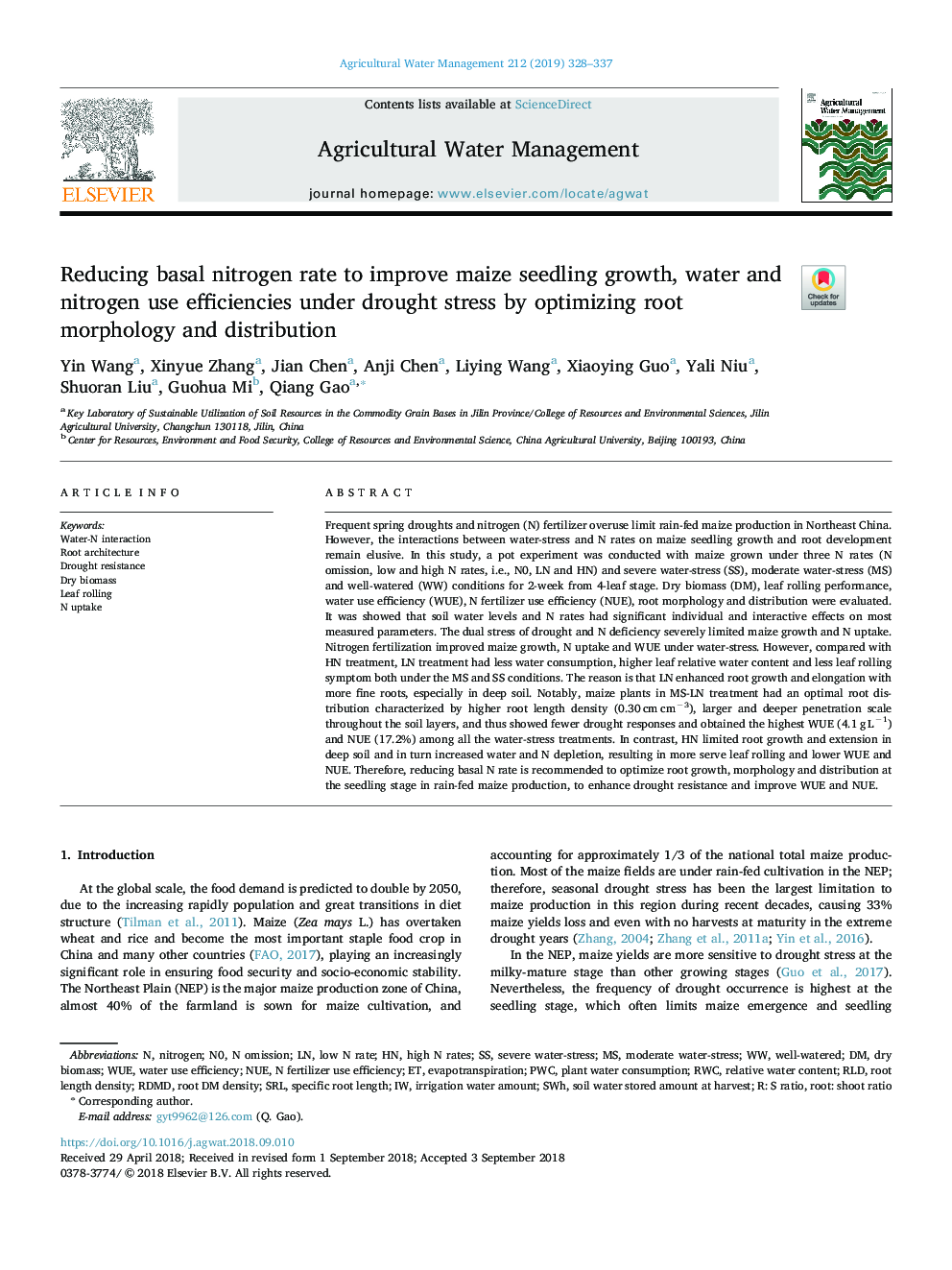| کد مقاله | کد نشریه | سال انتشار | مقاله انگلیسی | نسخه تمام متن |
|---|---|---|---|---|
| 10144817 | 1646309 | 2019 | 10 صفحه PDF | دانلود رایگان |
عنوان انگلیسی مقاله ISI
Reducing basal nitrogen rate to improve maize seedling growth, water and nitrogen use efficiencies under drought stress by optimizing root morphology and distribution
ترجمه فارسی عنوان
کاهش میزان نیتروژن پایه برای بهبود رشد گیاهچه ذرت، بهره وری استفاده از آب و نیتروژن تحت تنش خشکی با بهینه سازی مورفولوژی و توزیع ریشه
دانلود مقاله + سفارش ترجمه
دانلود مقاله ISI انگلیسی
رایگان برای ایرانیان
کلمات کلیدی
SWHPWCWUERLDSRLNUERWCwell-watered - آب آشامیدنیLeaf rolling - برگ نوردWater use efficiency - بهره وری استفاده از آبEvapotranspiration - تبخیر و تعرقroot length density - تراکم ریشهN uptake - جذب NRoot: shoot ratio - ریشه: نسبت شلیکDry biomass - زیست توده خشکspecific root length - طول ریشه خاصRelative water content - محتوای آب نسبیRoot architecture - معماری ریشهDrought resistance - مقاومت در برابر خشکسالیNitrogen - نیتروژن
موضوعات مرتبط
علوم زیستی و بیوفناوری
علوم کشاورزی و بیولوژیک
علوم زراعت و اصلاح نباتات
چکیده انگلیسی
Frequent spring droughts and nitrogen (N) fertilizer overuse limit rain-fed maize production in Northeast China. However, the interactions between water-stress and N rates on maize seedling growth and root development remain elusive. In this study, a pot experiment was conducted with maize grown under three N rates (N omission, low and high N rates, i.e., N0, LN and HN) and severe water-stress (SS), moderate water-stress (MS) and well-watered (WW) conditions for 2-week from 4-leaf stage. Dry biomass (DM), leaf rolling performance, water use efficiency (WUE), N fertilizer use efficiency (NUE), root morphology and distribution were evaluated. It was showed that soil water levels and N rates had significant individual and interactive effects on most measured parameters. The dual stress of drought and N deficiency severely limited maize growth and N uptake. Nitrogen fertilization improved maize growth, N uptake and WUE under water-stress. However, compared with HN treatment, LN treatment had less water consumption, higher leaf relative water content and less leaf rolling symptom both under the MS and SS conditions. The reason is that LN enhanced root growth and elongation with more fine roots, especially in deep soil. Notably, maize plants in MS-LN treatment had an optimal root distribution characterized by higher root length density (0.30âcmâcmâ3), larger and deeper penetration scale throughout the soil layers, and thus showed fewer drought responses and obtained the highest WUE (4.1âgâLâ1) and NUE (17.2%) among all the water-stress treatments. In contrast, HN limited root growth and extension in deep soil and in turn increased water and N depletion, resulting in more serve leaf rolling and lower WUE and NUE. Therefore, reducing basal N rate is recommended to optimize root growth, morphology and distribution at the seedling stage in rain-fed maize production, to enhance drought resistance and improve WUE and NUE.
ناشر
Database: Elsevier - ScienceDirect (ساینس دایرکت)
Journal: Agricultural Water Management - Volume 212, 1 February 2019, Pages 328-337
Journal: Agricultural Water Management - Volume 212, 1 February 2019, Pages 328-337
نویسندگان
Yin Wang, Xinyue Zhang, Jian Chen, Anji Chen, Liying Wang, Xiaoying Guo, Yali Niu, Shuoran Liu, Guohua Mi, Qiang Gao,
